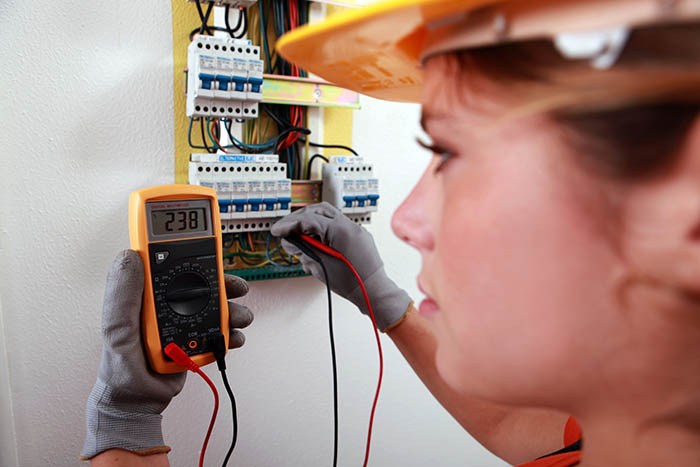
As an electrician, one of the most important things you can do is to constantly re-test your skills and see if they are up to par. It is easy to assume that you already know everything and fall into the commonplace yet dangerous trap of complacency. You think that there is nothing new to learn, and that there aren’t any new electrical products worth your time. That is, until something unfortunate happens and a gap in your knowledge base has been exposed.
Every electrician knows that safety is the most important value and it can never be compromised at any time. This basic rule is a fundamental part of providing exceptional service to your clients and customers.
With all of that in mind, we are going to provide 20 questions that will test your skills as an electrician. You will see if you are still able to perform basic tasks while catching any tricks that the question might be throwing at you. Keep in mind that these are general questions – you will be independently responsible for knowing things that are specific to your country, state and city.
After the questions, there will be a detailed answer key, followed by some resources to further your knowledge and a ranking scheme to judge how well you did on this quiz. Set aside an hour in your day, block out any distractions, and have a timer to keep you on track. Good luck!

1) Suppose that you have a run of electrical conduit. What are the MAXIMUM number of quarter bends that you can have between the outlets and the fittings?
a) 1
b) 2
c) 3
d) 4

2) Which of the following will flow through the circuit if you open a circuit contact and the arc in the circuit breaker happens to be absent?
a) High switch-over voltage
b) High current
c) High reactive power
d) None of the above

3) All grounds and/or short circuits can be contracted.
a) True
b) False

4) Out of the following items below, which one is NOT a source of electricity?
a) Wind
b) Friction
c) Magnetism
d) Chemical

5) All of the circuit breaker types mentioned below can be safely used in high power voltage systems, EXCEPT:
a) SF6 powered circuit breaker
b) Vacuum circuit breaker
c) An oil circuit breaker [this one]
d) Air-based circuit breaker

6) What unit does Ohm’s Law give you, and what is the correct formula for obtaining it?
a) Voltage, Amperes / Resistance
b) Voltage, Amperes * Resistance
c) Current, Voltage / Watts
d) Current, Voltage * Watts

7) If you have a series circuit that is powered by a source that provides 288 volts, and that circuit has three 12-ohm resistors, how much current is flowing through a single resistor?
a) 6
b) 8
c) 10
d) 12

8) An electrical transformer uses oil. What is the purpose of the oil?
a) The oil will act as a medium for insulation
b) both a) and c)
c) The oil will act as a coolant
d) The oil will act as a lubricant.

9) You are working in an industrial company and you see a piece of electrical equipment on the floor that needs to be put away. What do you do?
a) Do not touch it – assume it is live and find a competent person to assess what should be done
b) See if it is connected to anything, and if not, put it away.
c) Use personal protective equipment and touch it to see if you receive a shock.
d) Put it away – no harm will be done and your boss will thank you for it.

10) A Wattmeter is specifically designed to measure power in AC circuits only – it cannot measure power in DC circuits.
a) True
b) False

11) Eddy currents are circulation currents that are known to result in the loss of energy. Why is energy lost?
a) They are the result of an exothermic chemical change where the end result is a lower energy state.
b) The currents have an insufficient amount of amperes.
c) The pressure is not strong enough.
d) There are changes in the magnetic fields that take place within the conductor.

12) Which of the following energy types defines energy as being possessed by a body due to being in a certain position?
a) Thermal energy
b) Kinetic energy
c) Potential energy
d) Solar energy

13) When it comes to working with fuses, you need to replace an old fuse with a new one that is____
a) smaller than the old fuse
b) the same size as old fuse
c) larger than the old fuse
d) None of the above, since it doesn’t really matter.

14) What does GFCI stand for, and what is its purpose?
a) Ground Fault Current Induction, interrupts a current that encounters human skin before an injury can take place
b) Ground Fault Current Interrupter, stops a current in the case that a circuit breaker via grounding if a circuit breaker malfunctions.
c) Ground Fault Current Interrupter, interrupts a current that encounters human skin before an injury can take place
d) Ground Fault Current Inducer, stops a current in the case that a circuit breaker via grounding if a circuit breaker malfunctions.

15) One of the main problems with electrical switches is that oxidation and contact resistance frequently take place on the contact surface. What metal is used to prevent these two issues from occurring?
a) Iron
b) Copper
c) Titanium
d) Silver

16) Compared to a series circuit, every single electrical property is different within a parallel circuit EXCEPT for:
a) Voltage
b) Resistance
c) Power
d) Current

17) You can use extension cords as permanent wiring – they can be used to provide power for an infinite amount of time.
a) True
b) False

18) If you have a motor that is 100 Hz, and you provide it with 150 Hz, the motor’s speed is going to:
a) Stay the same.
b) It will increase.
c) It will slow down.
d) None of the above – there is no way to tell.

19) A first aid kit is entirely optional, and it only comes recommended when a job requires a certain amount of workers without any supervision whatsoever.
a) True
b) False

20) Assume that a transformer’s cooling stays at a certain level when it is placed on the ground. What will happen to the cooling ability if it is placed at a higher altitude?
a) It will become more efficient.
b) Nothing will happen to it.
c) It will become less efficient.
d) No way to know.


**If you are struggling to figure out why you were wrong, there are plenty of resources available online to guide you. As an example, this tutorial from Khan Academy will provide you with a great refresher on the introductory physics concepts related to electricity**
1) D
2) A
3) B
4) A
5) C
6) B
7) B – Remember that we are using a series circuit, and therefore the SAME current will flow through all resistors.
First, find the total resistance that exists within the circuit: 3 * 12 ohms = 36 ohms
Next, find the current that is flowing through the circuit: 288 volts / 36 ohms = 8 amperes.
8) B
9) A
10) B
11) D
12) C
13) B – picking “A” would lead to a current overload that could potentially become a fire hazard
14) C
15) D
16) A
17) B – they need to be used on a temporary basis, and disconnected as soon as the required job is done.
18) B
19) B – You need a first aid kit for ANY situation, no matter what. This is a basic safety rule that must be adhered to at all times.
20) C


0-5: Whoops! It looks like you need to do some serious re-education. Read up on all of your manuals and brush up on your basic mathematics skills. Talk to some other electricians and ask how they are able to keep their skills intact. You are in a state of crisis that needs fixing ASAP.

6-10: You’re not completely out of touch but it is apparent that you are not in the safe zone. It might also be the case that you made a lot of silly mistakes in your mathematical reasoning or read the question incorrectly. See where your mistakes were made, and try to fix them. This isn’t the end of the road, so don’t let yourself off too easily.

11-15: Not bad at all! However, as an electrician you want to ensure that you are always at your best. Re-read a few chapters from your manuals and spend some extra time fixing your weak spots. After a few hours of solid revision, you’ll be ready to get back into the game.

16-20: Congratulations! Short of a goof-up here and there, you know your stuff and you’re still on track towards maintaining your reputation as a competent electrician. Take note of the few mistakes that you made and resolve to prevent them in the near future.
